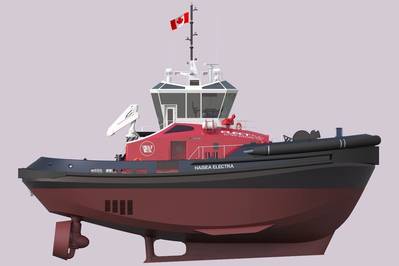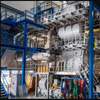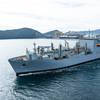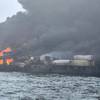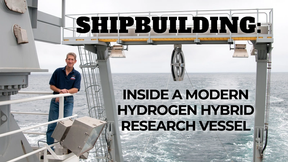LNG and Electric Tugs Ordered to Service the LNG Canada Project
A unique partnership formed between the Haisla Nation and North Vancouver-based Seaspan ULC will produce battery-powered and low emissions liquefied natural gas (LNG) dual fuel tugboats to serve the $40 billion LNG Canada project in Kitimat, B.C.
Majority-owned by the Haisla Nation, the new venture is called HaiSea Marine, which has a major contract with LNG Canada to build and operate escort tugs and harbor tugs required for the largescale LNG export facility. The company will provide ship-assist and escort services to LNG carriers navigating Douglas Channel and approaches in Kitimat Harbor.
The new escort and harbor tugboats are being designed by Vancouver-based naval architects and marine engineers Robert Allan Ltd. (RAL) featuring battery-electric power and natural gas instead of diesel fuel. They are slated to arrive well in time for LNG Canada’s first cargo at mid-decade.
At 28 meters in length, with approximately 70 tonnes bollard pull and 5240 kWh of battery capacity each, the first-of-class ElectRA 2800 battery-electric harbor tugs will perform the majority of their ship-berthing and unberthing missions on battery power. With ample clean hydroelectric power available in Kitimat, the harbor tugs will be able to recharge from dedicated shore charging facilities at their berths between jobs, effectively reducing emissions to near-zero. Because of their battery propulsion, they are also expected to be exceptionally quiet, both onboard and underwater.
In addition, larger RAstar 4000 DF vessels will be the most powerful Azimuth Stern Drive (ASD) escort tugs on Canada’s west coast, and will rank among the world’s highest-performing escort tugs. At 40 meters in length and with over 95 tonnes of bollard pull, they will generate indirect forces of approximately 200 tonnes. These escort tugs will perform the majority of their missions using natural gas as their primary fuel. The vessels will be capable of pollution response/oil spill recovery, firefighting of marine terminal fires, person overboard response, and emergency towage.
As a fleet, the new escort and harbor tugs are expected to reduce carbon dioxide emissions by up to 10,000 tonnes per annum compared to diesel-powered alternatives, with major reductions of nitrogen oxides, sulphur oxides, carbon monoxide, and particulate matter as well. In addition, all of the new tugs will be equipped with the external firefighting capability of 2,400 m3/hr.
“As majority owner of HaiSea Marine, we’re excited about the opportunities Haisla members will have working locally in the marine industry,” said Crystal Smith, Chief Councillor of the Haisla Nation. “It’s extremely important to us that aside from being one of the most powerful tug fleets on the west coast, it will also be one of the greenest ever assembled, anywhere.”
HaiSea’s Senior Project Manager, Captain Jordan Pechie, said the new partnership is a perfect fit. “Seaspan and the Haisla have hundreds of years of combined experience in these waterways,” he notes. “Our mandate is to operate at the highest level of safety and environmental standards, which will allow this legacy to thrive for generations to come.”
RAL President and CEO Mike Fitzpatrick also welcomed the opportunity to work with the Haisla Nation, noting that his firm already has a long-standing relationship with Seaspan. “We value highly the many quality shipyards with whom we have forged close working relationships over many years, and who have helped immeasurably to demonstrate the quality of our brand,” he said.
“The ElectRA 2800 and RAstar 4000 DF tugboats will be a welcome sight in Kitimat Harbour and Douglas Channel,” said Captain Mark Turner, LNG Canada’s Marine Superintendent. “They represent our commitment to federal and provincial authorities, First Nations, communities and joint venture partners, and demonstrate our operational safety philosophy, environmental stewardship with respect to zero emissions and underwater noise mitigation.”



